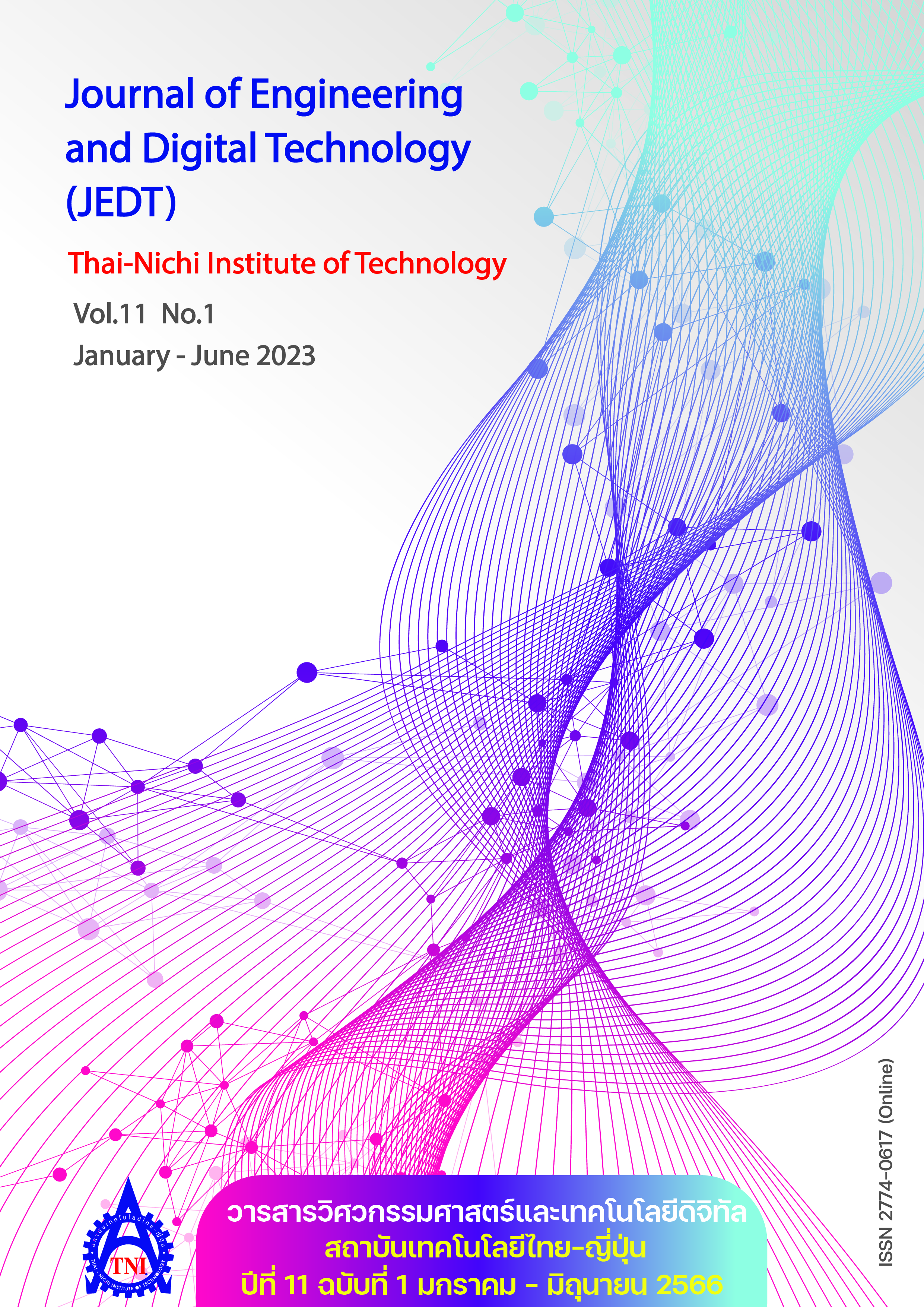Plant Layout and Design of Fabrication Laboratory Using Systematic Layout Planning and Process Layout
Main Article Content
Abstract
This research aimed to design the layout of the fabrication laboratory. The study applied the principles of Systematic Layout Planning (SLP) and Process Layout (PL), which focus on the relationship between work stations, flow processes, and groups of machines. The layouts were designed and simulated using the computer program. Criteria were used for minimizing the total moving distance and the total moving time to consider the suitable design. The results showed that the SLP gave a total moving distance of 565.84 meters per person and a total moving time of 609.64 minutes per person, while the PL provided a total moving distance of 609.31 meters per person and a total moving time of 646.25 minutes per person. In conclusion, the plant layout obtained from the SLP was better than the PL in terms of shorter total moving distance (7.13%) and less total moving time (5.66%).
Article Details

This work is licensed under a Creative Commons Attribution-NonCommercial-NoDerivatives 4.0 International License.
Article Accepting Policy
The editorial board of Thai-Nichi Institute of Technology is pleased to receive articles from lecturers and experts in the fields of engineering and technology written in Thai or English. The academic work submitted for publication must not be published in any other publication before and must not be under consideration of other journal submissions. Therefore, those interested in participating in the dissemination of work and knowledge can submit their article to the editorial board for further submission to the screening committee to consider publishing in the journal. The articles that can be published include solely research articles. Interested persons can prepare their articles by reviewing recommendations for article authors.
Copyright infringement is solely the responsibility of the author(s) of the article. Articles that have been published must be screened and reviewed for quality from qualified experts approved by the editorial board.
The text that appears within each article published in this research journal is a personal opinion of each author, nothing related to Thai-Nichi Institute of Technology, and other faculty members in the institution in any way. Responsibilities and accuracy for the content of each article are owned by each author. If there is any mistake, each author will be responsible for his/her own article(s).
The editorial board reserves the right not to bring any content, views or comments of articles in the Journal of Thai-Nichi Institute of Technology to publish before receiving permission from the authorized author(s) in writing. The published work is the copyright of the Journal of Thai-Nichi Institute of Technology.
References
C. Pornsing, S. Amphutsa, J. Kanchana-anothai, and P. Tharawetcharak, “Process and plant layout improvement using industrial engineering techniques: A case study sample LED light factory,” (in Thai), Thai Sci. Technol. J., vol. 27, no. 6, pp. 1132–1146, 2019.
T. Kongtong, P. Phanritdum, and C. Chamnanlor, “Simulation modeling to improve the efficiency of the steamed stuffed buns production,” (in Thai), SWU Eng. J., vol. 15, no. 2, pp. 71–80, 2020.
K. B. Bagaskara, L. Gozali, and L. Widodo, “Redesign layout planning of raw material area and production area using systematic layout planning (SLP) methods (case study of CV Oto Boga Jaya),” in Proc. 2nd Tarumanagara Int. Conf. Appl. Technol. and Eng. (TICATE), Jakarta, Indonesia, Nov. 2019, pp. 1–8.
P. Tearwattanarattikal, U. Kampoon, and S. Charoenvilaisiri, “Design of plant layout alternatives for the fruit and vegetable processing industry,” (in Thai), Sripatum Chonburi J., vol. 16, no. 4, pp. 28–38, 2020.
S. Chaisurayakarn, N. Limsuwan, B. Kabklon, R. Tiandum, R. Nannun, and R. Suwantechasit, “Business layout improvement with systematic layout planning concept: A case study of engine repair business,” (in Thai), J. Logistics and Supply Chain College, vol. 7, no. 2, pp. 64–80, 2021.
P. Homsri, “A plant layout improvement to increasing productivity: A case study downlight manufacturer,” (in Thai), J. Eng. Digit. Technol. (JEDT), vol. 9, no. 2, pp. 25–36, 2021.
R. Chanphaeng, M. Thumjaroen, and C. Pornsing, “Production layout using group technology for a medical device factory,” (in Thai), Thai Sci. Technol. J., vol. 26, no. 5, pp. 855–865, 2018.
K. Thatphet and P. Ruangchoengchum, “An elimination of non-value added movement by organizing production process layout: A case study of fresh coffee shop business in Khon Kaen province,” (in Thai), J. Manag. Sci. Ubon Ratchathani Univ., vol. 10, no. 2, pp. 1–24, 2021.
C. Bunterngchit, “Simulation-based application in warehouse layout design for reducing material handling time,” (in Thai), Kasem Bundit Eng. J., vol. 8, no. 3, pp. 1–14, 2018.
P. Sresracoo and K. Chantarasamai, “Simulation for improving service effectiveness of the medicine clinic at outpatient building, Mahasarakham hospital,” (in Thai), Kasem Bundit Eng. J., vol. 9, no. 3, pp. 184–200, 2019.
P. Manmor and T. Wasusri, “The reduction of patient’s waiting time at an outpatient department using simulation modeling : A community hospital in Suphanburi province,” (in Thai), Isan J. Pharm. Sci., vol. 15, no. 2, pp. 51–62, 2019.
T. Kongthong and C. Chamnanlor, “Simulation modeling to increasing the efficiency semi-trailer production,” (in Thai), KKU Res. J. (Graduate Stud.), vol. 21, no. 3, pp. 13–26, 2021.
Standards for Industrial Products: Paints and Safety Signs, TIS 635–2554, Royal Thai Government Gazette, Ministry of Industry, Mar. 1 , 2012. [Online]. Available: https://www.supakornsafety.com/wp-content/uploads/2018/12/unlocked.pdf


